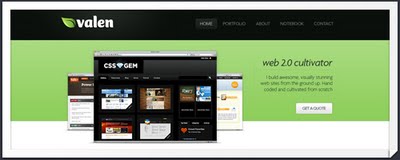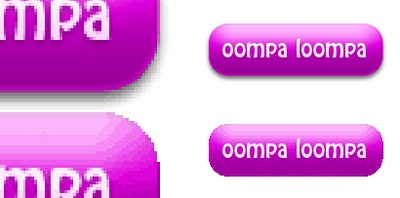This is just a quick post (well right now it appears in my mind that it will be but knowing how much I get carried away, it might be lengthy)... this is just a quick post talking about my experience with freelance clients, especially in a "bad economy."
Some of us like to have day jobs with a secure and predictable set income. Others are freelancers and contractors who want to be their own boss and have more freedom to stay up late, sleep in, and just go to the beach in the middle of the day if they wanted to... just live life more flexibly and freely. I have been doing both: work during the day and do freelance work at night and on the weekends, but instead of that added flexibility, I add less free time and more stress to my life. With the bad economy, I was laid off at the beginning of March, 2009. Being uncertain what will happen in the coming months, I ramped up my number of freelance clients in order to attempt to make up for the lack of "secure and predictable set income."
With this economy in the situation it is in, a lot of companies are laying off some of their creative staff to cut back on salary spending and they can easily do this because they are cutting back overall on budgets for advertising and other things that demand creative persons. I was one of these people.
CraigsList.org is a great place to pick up extra clients and some quick side jobs. This has been something that I have been using over the years in my freelance time at night and on the weekend. I have found my past three full time jobs on there as well.
The country is saturated with out-of-work creative professionals and there is a lot of competition. With that, there is a lot of freelance/contract gigs out there. It is a lot less expensive to hire someone to do a quick ad or website change for you than to have someone full time on your payroll who only has something to do once a week. Businesses are hitting up Craigs List and other sites like crazy and posting their ad for someone to do all this work that used to be handled in-house.
I will save this for another post, but even if you are a college student or someone just at very junior level looking to add something to your portfolio and gain experience, please do not do work for 1/10th the cost of what the going rate for something really is professionally done. This lowers the overall rates of the whole creative economy and will bite you in the future. We all start somewhere and we all are super happy to get those first few gigs and earn a few extra bucks, but such low rates gradually make everyone only want to pay these lowered rates since they can have a college student or "my friends son who knows Photoshop" do it. You do get what you pay for though, and that ends up sometimes making people who want better work firing their inexpensive creative person for someone who will get the job done good for a higher price.
So, to really start to get into what this blog post is about... just about all of us could use a few extra bucks in these harder times and we are more grateful for what we have and more willing to take these jobs with a lot lower compensation.
It is not about doing the same job for half the price or cutting your regular fee by 25% but more so what kind of client you will get. I always do these simple projects for friends and family for free and some more complex things for a very discounted rate just to cover some of my time that I have had to take away from other things that pay a little better. Friends and family do not count. What count are the clients who right away say they want this simple thing but for half the price of what the simple thing would normally cost you to do it. Almost 9 out of 10 times these clients end up blowing the project out and making it way larger and along with that, they end up being the most high maintenance and hard to work with. It feels like this is the case every single time and after talking to many other creative people that I have known over the years, they experience the exact same thing.
You get good at golf by playing it a lot and studying how to better your game. The same is applies to all other sports and also the creative trades such as graphic design, web design, and videography. It takes training, studying, and experience to get good at any of these creative trades. If you are just starting out, do not take ten of these small jobs with low pay. That will bring you some experience, sure, but it will 9 out of 10 times give you a huge headache and demand a ton of extra time and effort. Gain experience from taking one of those jobs that does pay well and is a larger project. Clients who are willing to recognize good
creative work and properly compensate for it tend to be a bit more organized and easy to work with. These projects go by easier and get finished up a lot sooner. Do one of those then with you extra experience, extra money (that makes you feel much better about yourself), and extra time saved with dealing with a more organized client... go snag another one of these better gigs. Be more picky with what you take... do not just take anything you can get, no matter what the pay is. If you are hurting that bad for money, go work part time at a grocery store or restaurant until you can make ends meet as a creative professional.
It is important to make sure that you obtain a decent deposit for the project before you start, along with a good contract with everything spelled out of exactly what you will be doing and what the process will be. This is added work on your end but will save you from a lot of potential problems. I just get lazy some times on "simple projects" that are low paying and do not create as detailed of a contract. Here are some recent examples...
I was looking hard for some extra cash from some quick jobs that I could do in my free time and was hired to do a "very basic
flash banner" for about $200 which is about half of what I normally would charge for anything like that... but I figured it wold be "very basic" and take me a few hours of an afternoon in a weekend. The project took three (3!!!) months to get finally completed and I met with the client three times while making several revisions and changes to the direction it went. Overall I most likely spent just about eight hours or so on it, including the in-person meetings, but for freelance that is a lot more time than $200 is worth. I am fair and easy to work with but low paying clients almost always bring trouble.
Another client wanted to go by an hourly rate for several easy projects and was only going to pay me about 30% of what my desired hourly rate is... but I calculated it would only be about an extra few hours a week that I would have spent watching TV or something non-constructive so I took the gig. Communication was lacking and the projects got drawn out way too long. The client wold give me non-detailed information, hardly email me any information, and would sometimes take half a week or so to return my emails or comment on what I had done... always giving good feedback though. I had also gotten sick three times, off and on, throughout the course of a month and a half so that added some delays due to health reasons. In the end I walked.
Throughout the process the client was very happy with the work being done and would make nice compliments on the quality of the work. In the end, they appeared to have run out of money on other projects with other contractors and changed their whole attitude toward everything and only wanted to honor about half of my hours and not even honor the full hourly rate decided on... but all, of course, only when the project was completed and they were most happy with it (essentially I was working for free if I wanted to finish this and make pocket change). I had dropped the ball a little bit on properly documenting (over email and other provable ways) some of the time spent but the process had been so good and the client was happy the whole way through... until the end. I was not charging them for the hours of phone conversations we had or the in-person meetings we had so in the end, I would only be making $170 out of the potential $500. I walked and closed communication with them. I am not going to take someone to court over something so little. It was just a huge wast of time and something that in the end just added to my stress level, which is high enough already. I assume that the client might have wanted to just steal my finished project and implement it later behind my back but if they do that I could take them to court, but now, I really do not care... I do not want them to know where I live to deliver payment by mail or by physically coming there. Some people are just scary and unreasonable and will use young and talented creative professionals like myself.
It is very easy for these underfunded businesses to prey on people to create something great for them and to then turn around and show complete disapproval and demand to not pay for it, only later to steal the work they had done. With web design, it is especially easy to do this. It is routine for you to sent the client several flat images (usually JPEGs) so the look is decided before any code is put down for the site. If you are not careful, these clients can hate your work all of the sudden in the end and decide not to go with you and just take your images, give them to a programmer, and save that whole cost of the design for the look and feel of the website.
When I was laid off I did the proper things needed to aid me in obtaining another full time job in my profession. I was still sick and my voice sounded like a frog so interviewing was kind of out of the question at that moment. Before I was able to interview, I needed to "make my self shine" in the huge pool of hundreds of people in
San Diego in my profession who are out of work or seeking something new work.
Image is everything. How you appear to those seeking someone to work for them is very important. I was not about to send out my resume that had not been updated in two and a half years or email people my outdated personal portfolio website, showcasing all my old work. I was going to take this time that I sounded like a frog and get my image pumped up a little.
I started by updating my resume with my last position held along with my long list of clients and what I did for all of them. I had originally categorized things by what I did for them (such as logo design, website design, etc...) but restructured it by having a Professional Experience section and then a Freelance Experience section where I just listed each business and a quick description of what I did for them. This allowed me to (barely) fit everything all on one page with pages following more of optional pages that were just letters of recommendation and references.
Other restructuring I later did was moving my design degree and design certificate (education) section further down. That was a mistake I had possibly made the mast couple of jobs by keeping it up there. I have been what I do since the year 2000 and this years makes it 9 years I have been doing this. If you stick your "training" up at the top, potential employers are going to think that it is one of your most important features and that you have only been doing what you do since the date you graduated. This was just a leftover from when I first created this when I was first graduating.
I am a young guy and had spent years as a freelancer and contractor even before I entered and finished my Certificate and then Bachelors Degree. Of course the five years of extra education I received for my professions also were five years I was also working in this field. I had a full time job as a lead graphic designer and web designer years before I finished my schooling and was freelancing at night and on the weekend. It is extra important to stick that education further down (even almost last on the page), especially if 80% of the space is filled by your list of positions you have held and long list of clients. If you have little experience and obtained all your knowledge and most of your experience in school, it is a lot more important to place that higher up on your resume.
Next came my portfolio. In the world of a person providing
creative services, they need to show off what they are capable of and most of that comes from the visual examples in their online portfolio. Years ago when I first touched Flash, I fell in love with the program and have been extensively using it ever since. Once I learned that program, right away I redesigned my website all in Flash and it looked fantastic. Flash is bad for SEO (search engine optimization) purposes but the only people viewing my website were going to be people I gave my website address to anyway so I decided to make a great looking
Flash website for myself (which ended up gaining me more clients). As I gained more and more experience, I realized how hard this thing was to maintain and add new projects to showcase. That site only lasted about six months before I scrapped it and redesigned a nice, clean, and simple HTML website that I could update in just moments.
After getting laid off, updating my website with projects that I had done for my previous employer and for freelance clients was easy. It just took me about an hour or so to nearly double what I had on there already.
I had my resume in order and my portfolio updated so I was ready to get out there and obtain new employment. The day I got laid off, I was already at work looking at what was out there on the long list of websites that companies post jobs on and was amazed by how many jobs were on there. During the time I was updating my resume and portfolio, and getting rid of the frog voice, I was constantly bookmarkng job listings that I am qualified for. Even though the economy is bad and everyone with a job right now is very thankful for it, I was still picky with what I took interest in. Disaster can provide opportunity and this was the case with my situation that many people would call a misfortune or a curse.
A week after I was laid off and after I regained my voice, I remained positive and confident that I could allow this situation to move me forward (and upward). I was confident that God and my resume and portfolio would provide me with a way to prosper out of what looked like a disaster. Having faith and confidence, I sent my resume out to only the businesses I desired to work for. I received a high percentage rate of calls and emails back and attended interviews just days after sending things out.
I was only out of work for two weeks and two days before I started my new job. Hearing that I beat 160 applicants they received within the first 48 hours of their listing, and a possible 250+ overall, brings a smile to my face. I have been blessed and a lot of that blessing can be blamed to have been given to me by God and the resume and portfolio.
It is also important to interview well and to have a good personality. It is also important to "dress to impress" at interviews and when meeting with large clients but I live in California, I am young, and I like to be comfortable. I do still put gel in my hair and do not wear a suit and tie to interviews. I buy a nice sweater vest, a nice collared shirt, and dress pants and cut back a little on the amount of gel (now more called styling putty or something like that) I put in my hair. You can look great like you are headed to the academy awards but if you are not able to prove what you are worth to a business or client you are interviewing with, you will not get far.
Have a great resume, well rounded and awesome portfolio, look nice, and be easy to talk to and you will succeed.





 Crysis had an amazing singleplayer and multiplayer and my team reached within the top five teams in the world for it but things are slowly fizzling out. People are losing interest now that the leagues are over. (You can see my previous post on Crysis.) It was recently announced that there will be another Crysis game coming out, Crysis Warhead, and it will be out soon.
Crysis had an amazing singleplayer and multiplayer and my team reached within the top five teams in the world for it but things are slowly fizzling out. People are losing interest now that the leagues are over. (You can see my previous post on Crysis.) It was recently announced that there will be another Crysis game coming out, Crysis Warhead, and it will be out soon. The new game, Warhead, takes place from the eyes of another one of Nomad's team mates named Psycho. Nomad interacted with different team mates throughout the game, here and there, but each team mate ended up seeing different things and going a different rout different times. Psycho spent the majority of the game away from Nomad on the other side of the island. Warhead is a story told from the eyes of Psycho. It is supposed to have a lot of new weapons, a ton of more action, and as good or even better of a story that shows what else happened on the other side of the Island. The first Crysis had a lot of exploring and not a lot of gigantic fight scenes with large explosions and heavy firepower. This new one is supposed to.
The new game, Warhead, takes place from the eyes of another one of Nomad's team mates named Psycho. Nomad interacted with different team mates throughout the game, here and there, but each team mate ended up seeing different things and going a different rout different times. Psycho spent the majority of the game away from Nomad on the other side of the island. Warhead is a story told from the eyes of Psycho. It is supposed to have a lot of new weapons, a ton of more action, and as good or even better of a story that shows what else happened on the other side of the Island. The first Crysis had a lot of exploring and not a lot of gigantic fight scenes with large explosions and heavy firepower. This new one is supposed to.